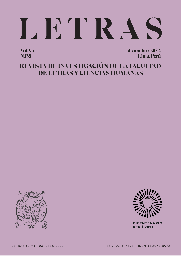The Buddhist ideal of bodhisattva. An historical outline of its ethical significance
DOI:
https://doi.org/10.30920/letras.93.138.8Keywords:
Bodhisattva, Theravada Buddhism, Mahayana Buddhism, Ethics, Virtues, CompassionAbstract
From the beginning of Buddhism, the figure of the bodhisattva appears, which, besides of being considered a stage prior to Buddhahood, became an ideal of realization open to anyone who wants to follow it. The bodhisattva is a complex ideal, since it encompasses different dimensions of human existence, such as the spiritual, intellectual, moral, psychological and religious. In this paper we want to present the value of this ideal, especially its ethical meaning, which has combined both theory and practice in those who have inspired their lives. We begin by looking at the etymology, the meanings in Theravada and Mahayana Buddhism, ending with the presentation of this ideal reviewing four contemporary Buddhist teachers. The relevance of this study is that this Buddhist ideal has brought to the Western mind a way of life full of meaning and because it can also be extended to the social commitments that individuals currently have.
References
Anālayo, B. (2010). The Genesis of the Bodhisattva Ideal. Hamburg University Press, Center for Buddhist Studies.
Anālayo, B. (2011). Brahmā’s Invitation: The Ariyapariyesanā-sutta in the Light of its Madhyama-āgama Parallel. Journal of the Oxford Center for Buddhist Studies, 1, 12- 38. http://jocbs.org/index.php/jocbs/article/view/2/2
Anālayo, B. (2022). Awakening or Enlightenment? On the Significance of bodhi. Insight Meditation Society. Insight Meditation Society. https://www.dharma.org/awakening-or-enlightenment-on-the-significance-of-bodhi/
Appleton, N. (2010). Jātaka Stories in Theravāda Buddhism Narrating the Bodhisatta Path. Ashgate.
Bodhi, B. (2019). En palabras del Buddha. Una antología de Discursos del canon pali. Kairós.
Bodhi, B. (2002). Introducción. En Thera, N. y Hecker, H., Grandes discípulos de Buda. Su vida, sus actividades, su legado. Dharma.
Brassard, F. (2000). The concept of Bodhicitta in Śāntideva’s Bodhicaryāvatāra. State University of New York Press.
Calle, R. A. y Mundy, S. (1981). El Sutra del diamante y la síntesis del budismo. Altalena.
Cleary, Th. (1993). The Flower Ornament Scripture. Shambala.
De Alejandro, S., Waksman, V. y Tola, F. (2003). Vidas anteriores de Buda. Jātakas. Primordia.
Dragonetti, C. (1964). Dhammapada. El Camino del Dharma. Universidad Nacional Mayor de San Marcos.
Dragonetti, C. y Tola, F. (2018). Vimalakīrtinirdeśha. La Enseñanza de Vimalakīrti. Fundación Bodhiyana.
Fatone, V. (1955). El hombre y Dios. Editorial Columba.
Ikeda, D. (2001). El nuevo humanismo. Fondo de Cultura Económica.
Ikeda, D. (2017). Develando los misterios del nacimiento y la muerte. Sabiduría budista para la vida. Soka Gakkai de México.
Ikeda, D. (2018). La construcción de un movimiento popular hacia una era de los derechos humanos. Propuesta de paz de 2018. Ediciones Civilización Global.
Kapleau, R. P. (1981). Zen. Amanecer en Occidente. Árbol Editorial.
Kelsang Gyatso, G. (2001). Ocho pasos hacia la felicidad. Tharpa.
Kelsang Gyatso, G. (2008). El Voto del Bodhisatva: Una guía práctica para ayudar a los demás. Tharpa.
Kelsang Gyatso, G. (2010). Compasión universal. Tharpa.
Kelsang Gyatso, G. (2014). Tesoro de contemplación: El modo de vida del Bodhisatva. Tharpa.
Loy, D. (2016). Un nuevo sendero budista. La búsqueda de la iluminación en el mundo moderno. Kairós.
Meneses, B. (2018). Zen. Una manera de vivir. Editorial Dana Paramita.
Nyanatiloka. (1980). Buddhist Dictionary. Manual of Buddhist Terms and Doctrines. Buddhist Publication Society.
Pániker, A. (2019). Las tres joyas. El Buda, su enseñanza y la comunidad. Kairós.
Piyadassi Thera. (1982). El antiguo sendero del Buda. Altalena.
Pujol, O. (2019). Diccionario sánscrito-español. Herder.
Ramírez, L. (2004). Sūtra de Vimalakīrti. Kairós.
Rodríguez, M. (2012). El budismo: una perspectiva histórico-filosófica. Kairós.
Śāntideva. (2012). Camino al Despertar: Introducción al Camino del Boditsatva (Bodhicaryāvatāra). Trad. de Luis Gómez. Siruela.
Schuhmacher, S. y Woerner, G. (Comps.). (1993). Diccionario de la sabiduría oriental. Paidós.
Schumann, H. W. (2007). Las imágenes del budismo. Diccionario iconográfico del budismo mahāyāna y tantrayāna. Abada Editores.
Skorupski, T. (2013). The Buddhist Forum Volume VI. Institute of Buddhist Studies.
Solé-Leris, A. y Vélez de Cea, A. (2008). Majjhima Nikāya. Los Sermones Medios de Buddha. Kairós.
Thera, N. y Hecker, H. (2002). Grandes discípulos de Buda. Su vida, sus actividades, su legado. Dharma.
Tola, F. y Dragonetti, C. (1980). El Budismo Mahâyâna. Estudios y textos. Kier.
Tola, F. y Dragonetti, C. (2010). Saddharmapuṇḍarīkasūtra. El sūtra del loto de la verdadera doctrina. Dharma Translation Organization.
Villalba, D. (2009). Budismo. Historia y doctrina, vol. III: Zen. Miraguano.
Von Glasenapp, H. (1974). El budismo, una religión sin Dios. Barral Editores.
Wangchuk, D. (2007). The Resolve to Become a Buddha. A Study of the Bodhicitta Concept in Indo-Tibetan Buddhism. The International Institute for Buddhist Studies.
Williams, P. (2014). Pensamiento budista. Una introducción completa a la tradición india. Herder.
Žižek, S. (2012, 3 de septiembre). The Buddhist Ethic and the Spirit of Global Capitalism [Paper presentation]. European Graduate School, Saas-Fee, Suiza. https://egs.edu/biography/slavoj-zizek/
Downloads
Published
Issue
Section
License
Copyright (c) 2022 Miguel Ángel Polo Santillán

This work is licensed under a Creative Commons Attribution 4.0 International License.







